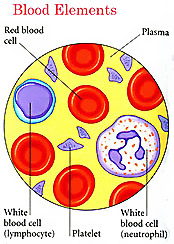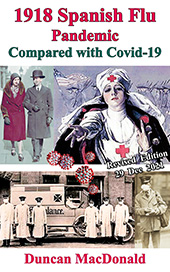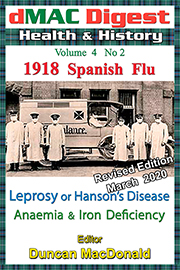Duncan MacDonald
Jakarta August 2006
What is Anaemia? Anaemia literally means 'lack of blood'. It is a condition where red blood cells fail to provide adequate oxygen to the body's tissues. This is due to either to either a lack of red blood cells or each cell carrying too little of the oxygen-carrying pigment haemoglobin.
Blood cells are created in the bone marrow and normally live for  approximately four months. When the balance of this mechanism fails the result is anaemia. Either the bone marrow produces too few blood cells, or the cells are destroyed or lost at too fast a rate.
approximately four months. When the balance of this mechanism fails the result is anaemia. Either the bone marrow produces too few blood cells, or the cells are destroyed or lost at too fast a rate.
About Blood Blood is made up of fluid called plasma which contains three types of cells;
• White blood cells – these are part of the immune system, the body's defence against infection
• Platelets – these are involved in blood clotting
• Red blood cells – these carry oxygen around the body in a pigment called haemoglobin
Anaemia isn't a disease in itself, but a result of a malfunction somewhere in the body.
What Causes Anaemia? There are several causes including;
• Iron deficiency in the haemoglobin – the most common cause worldwide. Lack of iron prevents the bone marrow from making sufficient haemoglobin for the red blood cells.
• Loss of blood through heavy menstruation. About 1 in 10 women become anaemic at some time in their life due to heavy periods.
• Pregnancy can lead to iron-deficiency anaemia because the growing baby needs iron and takes its supply from the mother. Iron deficiency is more likely to develop during pregnancy in women whose diet does not contain plenty of iron.
• Internal bleeding which may be caused by bladder or kidney disease, frequent blood donations, peptic ulcer or bowel cancer.
• Infections such as malaria or chronic diarrhoea.
• Shortage of vitamins B12 or folic acid, both needed to produce red blood cells
• Defective bone marrow caused by rheumatoid arthritis or cancer
• Hookworm infection can cause iron-deficiency anaemia. People who live in or travel to the tropics are at risk of hookworm infection. Hookworms feed off blood inside the intestines
Groups at High Risk
• Menstruating women lose iron and those who bleed heavily may become anaemic. Use of oral contraceptives is associated with decreased risk for iron deficiency.
• Pregnant women need three to four times their normal amount of iron to supply their growing foetus. Iron deficiency in pregnant women increases the risk twofold for a preterm delivery and a threefold risk of delivering a low birth weight baby.[3] A folic acid deficiency during pregnancy can result in infants being born with neural-tube defects, such as spina bifida. 
• Women who are breastfeeding should ensure they obtain adequate iron so that the child can gain weight and develop properly.
• Babies, especially if premature – especially ages six months to two years. Breast milk contains an adequate supply or iron for infants and many formulas are fortified with iron, so they do too. It is recommended that children be breastfed for up to 18 months but if they are not, and when complementary food (solid) is introduced they are at risk for anaemia.
This age group is in an important stage of growth and development – the brain is growing and learning, cognitive development is occurring, motor skills and behavioral development is happening. Iron deficiency has detrimental effects on all of these. It can cause the loss of 9 IQ points! It slows brain function, hurting coordination and motor skills. Iron is critical for complete child development.
• Adolescence – both boys and girls go through another stage of rapid growth. Without enough iron, full growth and mental development will not occur. Students will not learn as much. Fatigue, lethargy and apathy may effect social development and job capability. After adolescence boys are usually not effected by anaemia, their iron levels even out and with appropriate nutrition they will maintain adequate levels
Students will not learn as much. Fatigue, lethargy and apathy may effect social development and job capability. After adolescence boys are usually not effected by anaemia, their iron levels even out and with appropriate nutrition they will maintain adequate levels
• Vegetarians
• People with stomach ulcers
• People with cancer
• People with certain chronic diseases
Approximately 20% of women, 50% of pregnant women and 3% of men are iron deficient.[4]
The main cause of iron deficiency anaemia, is loss of iron at a greater rate normal as a result of abnormal or persistent bleeding.
Iron deficiencies and anaemia reduce the work capacity of individuals and entire populations, bringing serious economic consequences to and obstacles to national development. Conversely, treatment can raise national productivity levels by 20%. Overall it is the most vulnerable, the poorest and least educated who are disproportion ally affected by iron deficiency, and it is they who stand to gain most by its reduction. World Health Organisation, Micronutrient deficiencies |
Does Diet Play a Role? Iron is the essential component of haemoglobin, the oxygen carrying pigment in the blood. Iron is normally obtained through the food in the diet and by recycling iron from old red blood cells. Without it the blood cannot carry oxygen effectively – and oxygen is needed for the normal functioning of every cell in the body.
Good sources of iron-rich foods include;
• Meat (liver is the highest source), and egg yolks
• Chicken
• Fish
• Legumes (peas and beans)
• Fortified breakfast cereal
• Wholegrain bread and fruit (raisins)
The greater the contribution of meat, fish and vitamin C to the total diet, the more efficient will be the absorption of the iron.[5]
Vitamin C is important in the diet, since it converts iron to a form that can be well absorbed.
Coffee and tea block the absorption of iron and you should make an effort to drink these items 2 hours after eating your high iron meal. They should not be given to children.
What are the Symptoms ?
• Fatigue
• Concentration difficulties
• Rapid , weak pulse or palpitations
• Shortness of breath
• Drop in blood pressure when standing from a sitting or lying position. (orthostatic hypotension)
• Irritability
• Dizziness
• Brittle nails
• Pale skin
• Decreased appetite (especially in children)
• Tinnitus (ringing in the ears) – less common
• Sore tongue, cracked lips
• Blue tinge to sclerae (whites of eyes)
| Iron deficiency can also reduce attention span, cause behavioural and development problems in young children and weaken the immune system. |
How is Anaemia Treated?The most common way to treat iron-deficient anaemia is to prescribe an oral iron supplement (ferrous sulphate). The best absorption of iron is on an empty stomach, but many people are unable to tolerate this and may need to take it with food. Milk and antacids may interfere with abortion of iron and should not be taken at the same time. Vitamin C can increase absorption and is essential in the production of haemoglobin.
empty stomach, but many people are unable to tolerate this and may need to take it with food. Milk and antacids may interfere with abortion of iron and should not be taken at the same time. Vitamin C can increase absorption and is essential in the production of haemoglobin.
Supplementary iron is needed during pregnancy and lactation because normal dietary intake rarely supplies the required amount.
Some patients are given injections (intravenous or intra-muscular) if they cannot tolerate oral forms. Iron supplements can have side effects. These include constipation, diarrhoea, upset stomach or feeling sick. The stools may also turn black.
If iron depletion is severe, blood transfusions may be necessary.
Conclusion Because of their close linkages, iron deficiency and anaemia must be tackled simultaneously. The comprehensive intervention package features;
• Infection control. Public health measures to control hookworm infections, malaria and tuberculosis.
• Improved nutritional status. The best way to prevent iron-deficiency anaemia is to eat a diet containing plenty of iron. The recommended daily amount for men is 7 mg a day and for women 11 mg per day. Also diet diversification and infection prevention.
Iron-deficiency anaemia affects millions. The health consequences are stealthy but devastating, invisibly eroding the development potential of individuals, societies and national economies.
This need not be so. We not only know the causes; we also have solutions that are both inexpensive and effective.
This Digest article can be downloaded as a FREE e-book on Smashwords.
Available on iPad / iBooks, Kindle, Nook, Sony, & most e-reading apps including Stanza & Aldiko.
Just click the following link
>> download free e-book dMAC Digest Vol 4 No 2






